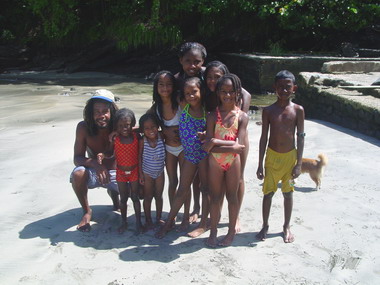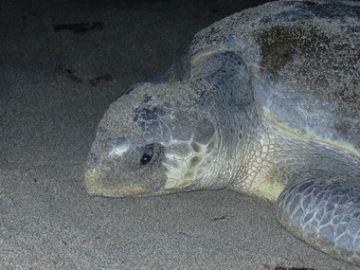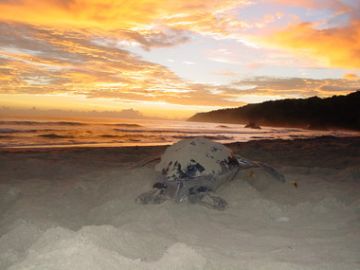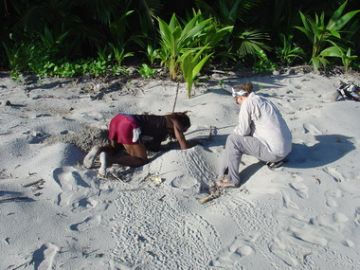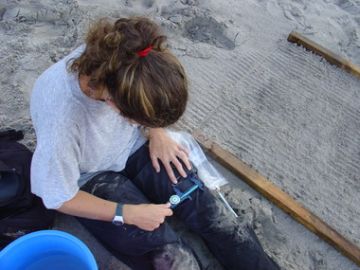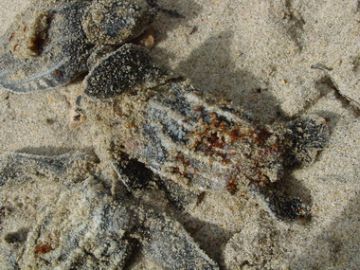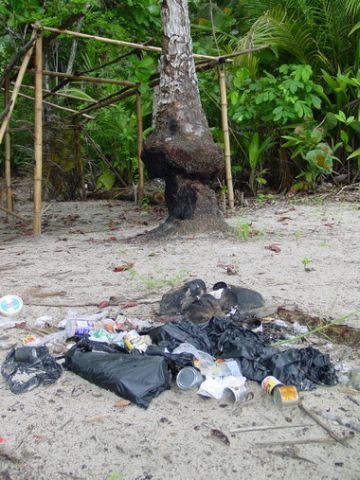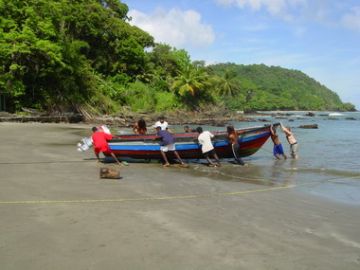Suzanne R. Livingstone & J.R. Downie
Division of Environmental and Evolutionary Biology, Graham Kerr Building, University of Glasgow, G12 8QQ
Email: s.livingstone{at}io.gla.ac.uk
Based on a presentation to the BCG Symposium at Chester Zoo, October 2003
Introduction
Trinidad is situated at the south end of the Caribbean island chain, 12km from Venezuela (Figure 1). Five species of marine turtle have been observed nesting on Trinidad’s north and east coasts (Figure 2). The leatherback turtle (Dermochelys coriacea) is the most common species and nests in considerable numbers. The leatherback rookery in Trinidad is the largest in the Caribbean, and is thought to be one of the largest in the Atlantic Ocean. Hawksbill (Eretmochelys imbricata) and green turtles (Chelonia mydas) nest in smaller numbers, and, according to local fishermen, have decreased in number over the last 30 years. Literature reports that olive ridleys (Lepidochelys olivacea) and loggerheads (Caretta caretta) also nest on Trinidad’s beaches, but as a rare occurrence (Bacon 1969; Fournillier and Eckert 1997; Livingstone, in press). All five turtle species nesting in Trinidad are listed as endangered or critically endangered on the IUCN red data list of threatened species (IUCN 2004).
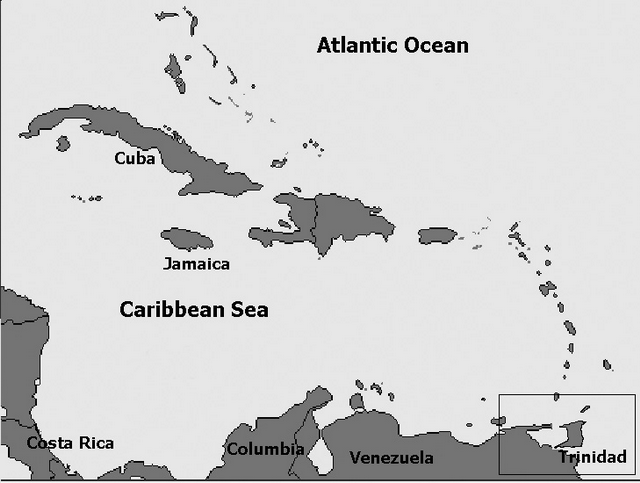
Figure 1. Location of Trinidad.
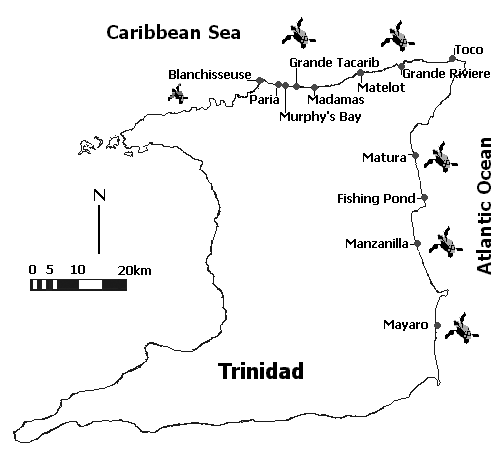
Figure 2. Marine turtle nesting beaches in Trinidad.
While the leatherbacks nesting on the east coast (Matura and Fishing Pond) and accessible north coast (Grande Riviere) beaches of Trinidad are well documented, before 2000 little was known about the turtle populations nesting on the remote northern beaches. The central strip of the coastline is undeveloped and there are no roads or habitations for approximately 22km between the villages of Blanchisseuse (west) and Matelot (east). This area of remote coastline is interspersed with a number of sandy bays on which marine turtles nest. The main beaches are Grande Tacarib, Paria, Murphy’s bay and Madamas, with a few smaller lower density beaches (Figure 3). The only way to reach these beaches is to hike through mountainous rainforest or by boat as the Northern Range mountains fall steeply into the Caribbean Sea. For this reason the beaches remain relatively untouched, although there has been illegal progression of the north coast road at the western end at Blanchisseuse, making it easier to reach Paria bay.
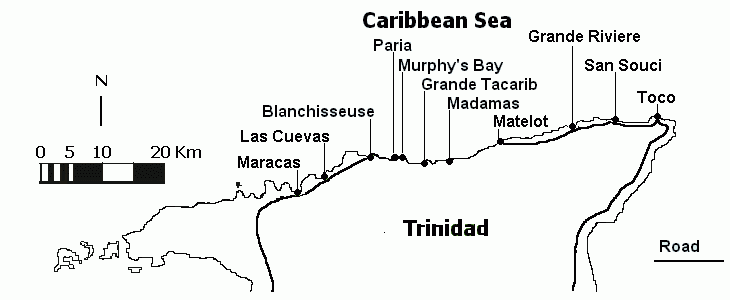
Figure 3. North coast beaches in Trinidad.
The scientific community has been aware that turtles use the remote beaches since turtle research began in Trinidad (Bacon 1969). However, monitoring was limited to brief overnight stays during hikes from one village to the other. The lack of accessibility meant that no extensive work was carried out in this area (Lum 2001).
The Darwin Project
The University of Glasgow Exploration Society carried out limited surveys of the north coast in 1989 and 1991 (Godley et al. 2001a; 2001b). A more detailed assessment was then carried out in 2000 (Livingstone et al. 2000). The 2000 study worked in collaboration with several local NGOs (Non Governmental Organisations) and managed to organise weekly trips to the beaches on the north coast, involving hiking and camping, and latterly travel by boat. This intensive study revealed much higher numbers of nesting leatherbacks than previously believed.
The work provided the contacts and the initial baseline data for a Darwin Initiative funded project. The Darwin Initiative is a grants programme funded and administered by the UK Government Department for Environment, Food and Rural Affairs (DEFRA). The Initiative aims to promote biodiversity, conservation and sustainable use of resources in less developed countries using British expertise. The programme stresses the importance of host country links and endeavours to leave behind a legacy, allowing projects to continue into the future.
Our project was set up to support community development, training, and turtle research and monitoring in the north coast area for a two-year period (2002-2004). The main objectives were to accurately estimate the populations of all species of marine turtle nesting on the remote and more accessible beaches, to identify the threats to the turtles and their nests, and to train a group of local people to be able to continue monitoring the populations into the future.
Project partners and community development
This Darwin project was largely centred on the participation of two local NGOs. The Grande Riviere Nature Tour Guide Association (GRNTGA) has been monitoring the turtles on their beach since 1996. Grande Riviere beach is the highest density beach in Trinidad with up to 300 leatherbacks coming up to nest in one night during the peak season. The beach is now a designated protected area, and a permit is required to gain entrance to the beach at night during the turtle season. The members of GRNTGA monitor the turtles on the beach, and take groups of tourists on guided tours to generate funds for their conservation work. The Pawi, Sports, Culture and Eco Club, based in Matelot, were our main NGO partner. Previous to this project they had no formal training in turtle monitoring methods, however, they were keen to work on the remote north coast beaches. They now carry out all the monitoring of the marine turtles nesting on the beaches, participate in other activities in the area such as litter control, and interact with the fishermen who accidentally catch turtles in their nets.
The University of Glasgow Darwin project team comprised a researcher (S.R. Livingstone), a group of student volunteers and a staff co-ordinator (J.R. Downie). Members of both NGOs attended a 6-week turtle biology and conservation course that we offered at the beginning of the project. The course was aimed at any interested persons in the area and was designed to expand their knowledge and understanding of conservation, largely orientated around sea turtles, although other aspects of Trinidad’s rich biodiversity were also reviewed. The course was also an excellent opportunity to exchange information, and the Darwin team gained invaluable local knowledge of the area and turtle populations.
Twenty-three local people participated in the course and from these we created strong links with the local groups, and established a team to carry out the monitoring work on the remote north coast beaches. This involved training in data collection, tagging, and experimental design. The groups were fundamentally involved in the monitoring and research and this made up much of their training in field techniques. This training was essential for the continuation of the project into the future once Darwin funding ran out.
The Trinidad Government’s Wildlife Section provided the host country coordinator for the project. Their support was accommodating throughout the project. It was important for the project to help the government meet their obligations under the Biodiversity Convention, and to supply them with data for their National Marine Turtle Database managed jointly by Nature Seekers, an NGO based at Matura, and the Wildlife Section. We also helped with raising awareness of the endangered status of turtles in areas where it was difficult for wildlife staff to reach.
As well as educating adults, it was important to raise awareness amongst the young people in the area. Throughout the project we were allowed to take over several biology classes in the local high school (Matelot Community College), and a teaching programme was developed to educate the pupils about turtle conservation and ecology. This was considered very successful and enjoyed by all (photo 1).
Ecotourism
All Darwin projects require there to be a sustainable element to the project, and so it was our aim to be able to hand over the project management and all equipment bought with the project grant to our local counterparts. To achieve this there needed to be a means of making revenue as the equipment alone could not sustain the project. Funds are required to carry out the work on the beaches, which is time consuming and physically challenging. Most of the local team members had other jobs, and needed to be able to make at least the same amount of income from the turtle monitoring for it to be a realistic alternative to their normal employment. A large focus of the project was to find this means of income. Although it is a useful method of generating funds, relying on funding from outside sources is not always dependable. It is also difficult considering the NGO’s limited access to information and the resources necessary to apply for available grants.
The best way to make the project sustainable was through ecotourism. The GRNTGA were already making funds this way by taking tours on Grande Riviere beach during the turtle season, and taking people on hikes to see waterfalls and to do bird watching in the surrounding area. This was much more difficult for the Pawi Club, however, as Matelot does not have the same facilities as Grande Riviere. There are no hotels, and there is no turtle beach in the village. Matelot is in no way currently set up for tourism. One of the project aims was to design an ecotourism activity using the remoter beaches so that monitoring could be done in conjunction with ecotours to the beaches. This would make turtle conservation an option for generating revenue in such a low-income rural village through sustainable ecotourism. It was proposed that this sort of trip would appeal to people wanting a more adventurous holiday involving hiking and camping, different from the experience offered in the village of Grande Riviere.
During the project we investigated the ecotourism potential of the area by bringing three separate ecotourist groups of varying ages (school group, gap year group and a more mature adult group) from Britain. The trips were a great success and have proved to be an economically viable option for generating funds for turtle conservation in the area. The main difficulty currently is the ability of the NGOs to organise these trips due to lack of facilities. However, we did organise several impromptu trips with people visiting Grande Riviere. This offers a realistic opportunity for the Pawi Club for the moment, while the logistics of organising visitors from overseas are ironed out. There is certainly great potential for this type of ecotourism for the future. Ecotourism in Trinidad at this time is at an early stage of development; however, the nation appears to be making a conscious move to embrace it and the economic benefits it offers.
Population estimates and tagging
Current reports from around the world indicate profound long term declines in sea turtle populations (Spotila et al. 1996; 2000; Troeng et al. 2004). This trend fits with the apparent diminution of four of the turtle species using Trinidad’s coastline. During the three years of the project we witnessed only one olive ridley turtle (Livingstone, in press), and four green turtles (photo 2). We never saw any loggerheads. There are no past estimates in the literature for these species. The only information we had was from the older fishermen in the area, who all agreed that numbers were less now than 30 years ago. Hawksbills were a more common sight, and we witnessed at least one or two laying most times we were on the beach after June – their season starts later than the leatherbacks which nest from March to August.
From looking at past estimates of leatherback populations in Trinidad (Bacon 1969; 1970; 1981; Chu Cheong 1990; Godley et al. 1989; 1991; Nathai-Gyan et al. 1987), however, there is substantial evidence for a recent increase in this species. It is unclear why this has occurred. It could possibly be due to pressures on nesting beaches elsewhere, e.g. coastal development and human disturbance, causing the turtles to seek out new nesting sites. There have also been reports of leatherback population increases at other nesting sites in the Caribbean e.g. St Croix (Boulon et al. 1996). The limited data available on past numbers of leatherbacks on the north coast makes it difficult to make statistical comparisons between past studies and this one; however, it is clear that numbers of nesting females have increased over the last 40 years. It was calculated recently that 88% of leatherbacks nesting in the Caribbean use the beaches in Trinidad (Eckert 2005). Trinidad is clearly a significant region for nesting leatherbacks in the Caribbean and globally, in the context of serious declines elsewhere.
In 2004, we began tagging the leatherbacks on the north coast beaches. We tagged 322 females, 42 of which were recorded returning during the study. The tagging has already provided interesting information on the nesting females, and, if continued, will generate information that can be used for conservation and management in the future.
Nest ecology research
During the adult monitoring on the beaches, several other avenues of research into leatherback ecology were explored. Studies on nest ecology were carried out, focusing on nest temperatures and sex ratios, hatching success, hatchling fitness and insect infestation (photos 3, 4 and 5).
These projects are all directly relevant to the conservation of the leatherbacks. All marine turtles employ temperature-dependent sex determination (TSD). The pivotal temperature is where equal numbers of males and females develop, with higher proportions of males occurring at lower temperatures and females at higher temperatures. The pivotal temperature for leatherbacks is 29.5°C (Rimblot et al. 1985; Rimblot-Baly et al. 1987). Many studies have shown high female biases being produced and have suggested that this could be due to climate change and global warming. From this viewpoint it is interesting to note that all nest temperatures we recorded were below the pivotal temperature in the leatherback nests on the north coast beaches. It is therefore likely that the majority of hatchlings produced on these beaches are male, and that the area could therefore be important for the production of male leatherbacks in the Atlantic. We think it likely that seasonal temperature changes are an important factor.
The hatching success (percentage of turtles that emerge from a nest that are observed hatching or found after hatching) on the beaches was found to be 69% over all the beaches. This is relatively high compared with other areas. 12.6% of nests were infested with insects of some type (ants, Dipteran flies or other species such as beetle larvae or mole crickets). The maggots of flies were the most common infestation. It was concluded that most infestation was not harmful to the hatchlings, and that the insects were attracted to hatchlings that were already dead rather than causing the deaths in the first place. Red ants did cause hatchling deaths, but they were a rare occurrence.
The data from these research projects are currently being analysed and written up as separate papers, and will be submitted for publication in the near future.
Threats
One of the project aims was to identify the threats to nests, hatchlings and adult turtles. The main threats to the nests and hatchlings on the remote beaches were natural – erosion and build-up of sand by wave action and river movements, and predators such as crabs, vultures and opossums on land, and frigate birds, sharks, and other predatory fish in the sea. The collection of eggs by forest men living in the mountains was witnessed on several occasions. However, they only took eggs very occasionally and this was not considered to be a serious threat. Because the beaches are so inaccessible they are largely free of the human-related dangers that threaten survival on developed beaches. The situation is very different at Grande Riviere where there are humans all around. The survival rate of nests is much lower in Grande Riviere than on the remote beaches. There is much more predation, largely by dogs, which dig up many of the nests. This then attracts large numbers of vultures. Grande Riviere beach also suffers from more erosion than the other beaches due to a dynamic river system and larger sand particle size.
Threats to adults on the beaches were also relatively rare. There were a few occurrences of slaughtered females (six leatherbacks in four years of study), although there were more incidences of slaughtered hawksbills in the latter years of the project. This is possibly driven by the increased number of people using the coastline for recreation. Leatherbacks are rarely taken for meat, as people tend to regard leatherback as less palatable than other species. Adult slaughter on Grande Riviere beach has been totally eliminated now due to the protected status of the beach and the presence of the GRNTGA. The biggest threat identified to the leatherbacks and other species on the north coast (and in the whole of Trinidad) is the accidental catch in fishing nets (termed "bycatch") (Pritchard 1984; Eckert and Lien 1999; Lum 2003).
Currently the populations of turtles nesting on the remote beaches are relatively safe from human disturbance. However, a controversial proposal by the Trinidad government to develop the north coast for tourism puts this in serious jeopardy. The proposed development includes the completion of the east-west road as an “ecotourism highway” to, amongst other things, assist timber extraction from the northern range forest reserves. The illegal construction road has already begun on the west side, explaining the significant increase in tourists visiting the nearest beach from the road end – Paria. In the last five years, the number of people frequenting this beach has increased hugely and so has the amount of rubbish they have left (photo 7).
The majority of the Matelot community is very much against the construction of the road. The Government has sought little or no opinion from the local people. Such a development could be highly detrimental to the turtle population through easy access for poaching, artificially lit development on beaches, and what may be uncontrolled disturbance from people on the beach. It would also diminish pristine forest and affect the rich diversity of flora and fauna in this area. It is a recommendation of the Darwin Initiative project to turn the north coast into a National Park as an alternative, where community groups can encourage small-scale ecotourism ventures rather than open it up to big investors from which the local communities would gain little benefit.
Conclusions
Since the beginning of this Darwin Initiative project, there has been much progress. As well as monitoring the turtle populations, the project has also supported a number of research projects into the ecology and conservation issues of marine turtles. This information will be used to make informed decisions about future turtle management in the north coast area. A population estimate for the leatherbacks on the north coast has now been achieved, allowing continued monitoring to show up any changing trends in the population and contributing to world population estimates. The continuation of the tagging programme will also provide important information about inter-nesting migrations and the number of nests laid in a season. This work can be maintained with the newly acquired skills and knowledge of the local community groups, and the pledged support of the Government to fund the monitoring and data collection.
Bycatch of turtles in fishing nets has been identified as the most serious threat to the turtle populations in Trinidad, and the Fisheries Division and Wildlife Section of the Government are now working towards bringing in new methods of fishing as mitigation. The Caribbean Network for Integrated Rural Development (CNIRD) is now also working with the Matelot NGO on a biodiversity study, with potential for further work with the Caribbean Regional Environmental Programme (CREP) and United Nations Development Programme (UNDP). The involvement of these organisations is imperative to the continuation of the monitoring work. So far, the project is proving to be sustainable, and with further development of the ecotourism venture will give the project the extra stability that is required, and hopefully create more jobs within the community.
Overall the project has been a success, and the University of Glasgow plans to build on their strong links with the NGOs and the Wildlife Section, and continue to assist with turtle conservation in Trinidad.
Acknowledgements
We wish to thank the Darwin Initiative who largely funded this project. We also wish to thank the People’s Trust for Endangered Species and the British Chelonia Group for additional funding and support. Thanks also to our Trinidadian counterparts: Stephen Poon; the Trinidad Wildlife Section; Pawi, Sports and Eco Club; Grande Riviere Nature Tour Guide Association, and Nature Seekers; and our many friends in Trinidad, without whose help this project would not have been possible. Much gratitude is due to the Matelot Community College and Primary School where the training and education sessions were held. Thanks also to Dan Thornham for comments on a draft of this paper, and to the teams of Glasgow University student volunteers who helped with the project.
References
Bacon, P.R. (1969). The leatherback turtle project, progress report 1967-1968, and recommendations. Journal of Trinidad Field Naturalist Club. pp 8-9.
Bacon, P.R. (1970). Studies on the leatherback turtle (Dermochelys coriacea) in Trinidad, West Indies. Biological Conservation 2:213-217.
Bacon, P.R. (1981). The status of sea turtle stocks management in the Western Central Atlantic. WECAF Studies no. 7. Interregional Fisheries Development and Management Programme, Panama.
Boulon Jr, R.H., Dutton, P.H. & McDonald, D.L. (1996). Leatherback turtles (Dermochelys coriacea) on St Croix, U.S. Virgin Islands: fifteen years of conservation. Chelonian Conservation and Biology 2(2) 141-147.
Chu Cheong, L. (1990). Studies on the leatherback turtle (Dermochelys coriacea) in Trinidad. Caribbean Marine Studies 1:48-53.
Eckert, K.L & Eckert, S.A. (1990). Embryo mortality and hatch success in in-situ and translocated leatherback sea turtle (Dermochelys coriacea) eggs. Biological Conservation 53:37-46.
Eckert S.A. & Eckert, K.L. (2005). Size and status of insular Caribbean leatherback nesting populations. Atlantic Leatherback Strategy Retreat.
Eckert, S.A. & Lein, J. 1999. Recommendations for eliminating incidental capture and mortality of leatherback turtles (Dermochelys coriacea) by commercial fisheries in Trinidad and Tobago: A report to the Wider Caribbean Sea Turtle Conservation Network (WIDECAST). Hubbs-Sea World Research Institute, Technical Report no. 2000-310. 7 pp.
Fournillier, K. & Eckert, K.L. (1997). WIDECAST Sea turtle recovery action plan for Trinidad and Tobago. CEP Technical Report no.38. UNDP Caribbean Environment Programme, Kingston, Jamaica.
Godley, B.J., Kirkwood, K., Raffan, S. & Taylor, R. (2001a). Leatherback turtles in Trinidad. Marine Turtle Newsletter 52:16-17.
Godley, B., Broderick, A., Blackwood, S., Collins, L., Glover, K., Mcaldowie, C., McCulloch, D. & McLeod, J. (2001b).1991 Survey of marine turtles nesting in Trinidad and Tobago. Marine Turtle Newsletter 61:15-18.
IUCN. (2004). IUCN Red List of Threatened Species.
Livingstone, S.R., Rudd, S., Barr, J., Jamieson, D. & Archibald, K. (2000). Marine turtle conservation. In: S.R. Livingstone (editor), University of Glasgow Trinidad Expedition 2000 – Final report. Glasgow University Exploration Society, University of Glasgow. Scotland. pp 17-33.
Livingstone, S.R. (In press). Report of olive ridley (Lepidochelys olivacea) nesting on the north coast of Trinidad. Marine Turtle Newsletter.
Lum, L.L. (2001). Sea turtle research and conservation in Trinidad and Tobago. Institute of Marine Affairs.
Lum, L.L. (2003). An assessment of incidental turtle catch in the gillnet fishery in Trinidad and Tobago, West Indies. National Fish and Wildlife Foundation, USA/Institute of Marine Affairs, T&T. Project #00-026-055.
Nathai-Gyan, N., James, C. & Hislop. G. (1987). National report for the country of Trinidad and Tobago to the Western Atlantic Turtle Symposium II. Mayaguez, Puerto Rico, USA. October 1987.
Pritchard, P.C.H. (1984). Marine turtles in Trinidad and Tobago. Report on a consultancy to the Food and Agriculture Organisation (FAO) for preparation of plans for the management of marine turtles.
Rimblot, F., Fretey, J., Mrosovsky, N., Lescure, J. & Pieau, C. (1985). Sexual differentiation as a function of the incubation temperature of eggs in the sea turtle Dermochelys coriacea (Vandelli, 1761). Amphibia Reptilia 6:83-72.
Rimblot-Baly, F., Lescure, J., Fretey, J. & Pieau, C. (1987). Temperature sensitivity of sexual-differentiation in the leatherback, Dermochelys coriacea (Vandelli, 1761) - data from artificial incubation applied to the study of sex ratio in nature. Annales Des Sciences Naturelles-Zoologie et Bologie Animale 8:277-290.
Spotila, J.R., Dunham, A.E., Leslie, A.J., Steyermark, A.C., Plotkin, P. & Paladino, F.V. (1996). Worldwide population decline of Dermochelys coriacea: Are leatherback turtles going extinct? Chelonian Conservation and Biology 2:209-222.
Spotila, J.R., Reina, R.D., Steyermark, A.C., Plotkin, P.T. & Paladino, F.V. (2000). Pacific leatherback turtles face extinction. Nature 405:529-530.
Troeng, S., Chacon, D. & Dick, B. (2004). Possible decline in leatherback turtle Dermochelys coriacea nesting along the coast of Caribbean Central America. Oryx 38:395-403.Troeng, S., Chacon, D. & Dick, B. (2004). Possible decline in leatherback turtle Dermochelys coriacea nesting along the coast of Caribbean Central America. Oryx 38:395-403.
Testudo Volume Six Number Two 2005
Top




